Japanese Restaurants (worldwide)
Japanese Restaurants (worldwide)
This page is a Working Progress and will be Updated further. Let us know of any Dead Links by sending us an Email
This page is a Working Progress and will be Updated further. Let us know of any Dead Links by sending us an Email
Many of us have heard the words ‘I will love you ‘till the end of time’ but how many people have actually kept this promise? Well, 71 year-old Kazuyoshi Ueno has kept his love for his late wife Michiko burning more than two decades after she perished in the Great Hanshin Earthquake that devastated their home town of Kobe, Japan on 17th January, 1995.
Two of the most popular Japanese related food in America? Answer: How about Wasabi and Salmon.
The kick of the wasabi is what makes it so unique and a bit addictive. You just want more of it. Where salmon, is a very popular fish in North America and you can get them pretty fresh considering that they can be found in the Pacific Northwest and Alaska.
Ramen brings with it the inevitable memories of college dorms and low budget emergencies. While it is undoubtedly one of the most popular comfort foods, the fact of the matter is that ramen does not have to be the thin broth and dehydrated noodles staple that many seem to be having. The key to a good ramen, as any cook will tell you, is the consistency and flavor of the ramen broth.
Japanese people are amazingly open-minded and fearless when it comes to trying out new foods. This open-mindedness and love of new food has created a real trend in Japan: international foods made in Japan, or adapted for the Japanese consumer. These type of food are called Yoshoku, a westernized dish that has been incorporated into Japanese Food culture. Japan is particularly fond of Italian food, called "itameshi" in Japanese.
What is great about Japan is the quality of food and it doesn’t depend on the cost. What I mean is that you can get really cheap food and it’s tasty.
When I was in Tokyo, I had to catch a flight early next morning. I’m always hungry first thing in the morning so the fact I had to be at the airport at 9am didn’t give me much time, especially I had to catch the hotel shuttle.
Early in the 20th century, sheep was imported to Japan not only for wool but for eating. Several sheep farms could be found throughout Japan during that time. Several years later most of these farms were removed/demolished by the government Japan.
The only places that you could find Lamb in Japan as an edible source, was in the northern province of Hokkaido. It was there, that the name Genghis Khan was used for the dish Jingisukan(basically grilled lamb).
Okinawan cuisine is very different from mainstream Japanese cuisine. While rice is adopted as a staple, the local food prepared is also completely different. The Ryukyu Kingdom, which is forbearer to Okinawa, gathered quite a lot of its culinary disciplines and designs from the China and other Asian trading nations of the world including Thailand and Korea.
In the cuisines of Okinawa, there’s an unexpected disregard for fish and other sea foods. Pork is the most loved food here, and it is eaten from top-to-tail, including even the ears (mimiga). Pork has existed from the time the Chinese introduced it in the 14th century. The pork served in Okinawan cuisines is always slow cooked to maintain its tenderness and to eliminate the fat. Below is a platter of pork strips or bacon, with a dipping sauce(mixture of mirin, mustard and other unknown ingredients).
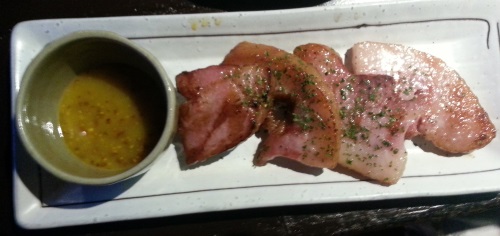
Unlike the mainstream food of Japan, Okinawan cooking has vegetables as its staples. Most of the vegetables involved, such as bitter melon and mugwort, are not part of the mainstream cooking in Japan.
With that said, here are some of the most popular delicacies of Okinawa:
You can’t talk about Okinawan food without mentioning Okinawa’s unique dish, Goya champuru. Locals prepare this dish in many different ways. It can be deep-fried like tempura, thinly sliced and thrown in salads or pickled for use as a side dish. Goya is full of Vitamin C, making it terribly sour when consumed raw. You’ll often find it served with tuna or scrambled eggs.
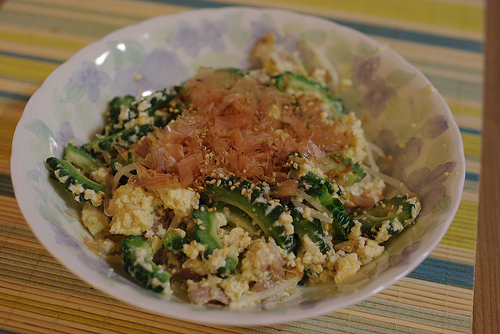
 by pelican
by pelican
Rafute, which is made up of succulent pieces of pork’s belly area simmered in soy sauce and glazed with brown sugar, definitely has a mass appeal. The dish was invented in China, but can be easily found in places like Okinawa and other Asian countries.
With bonito fish flakes and konbu (kelp) swimming in the clear broth of pork, Okinawa soba noodles are slightly chewy.
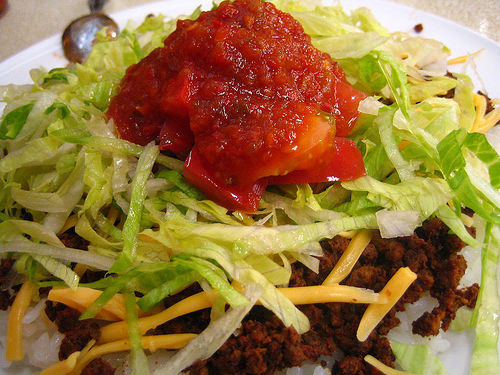
 by ayustety
by ayustety
Visitors often find themselves perplexed by the taco rice -- a bowl of salsa, cheese and spiced ground beef served on top of white rice. Just consider it Okinawa’s reply to the West’s taco salad.
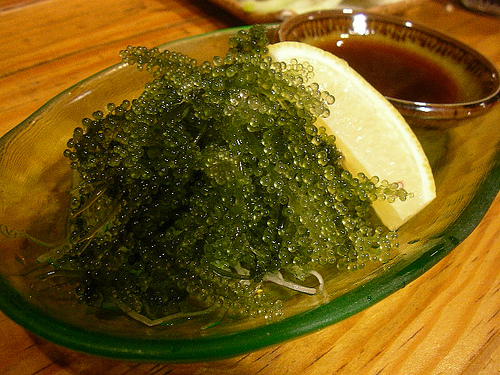
 by jetalone
by jetalone
As suggested by the name umi budo (sea grapes), these fine seaweed clusters resemble small bunches of grapes. Their texture is really a wonder. Offered with a spicy ponzu dipping marinade, the jewel-toned bubbles often pop in your mouth like a caviar.
Okinawans have adopted this Japanese main course wholeheartedly. Using local ingredients like sweet potatoes and goya instead of prawns, this dish is generally served with eggplant and mushrooms.
Almost all of us love donuts. Rather than being fluffy with deep brown crust covering a cakey center, Sata andagi is more a heavyweight cruller.
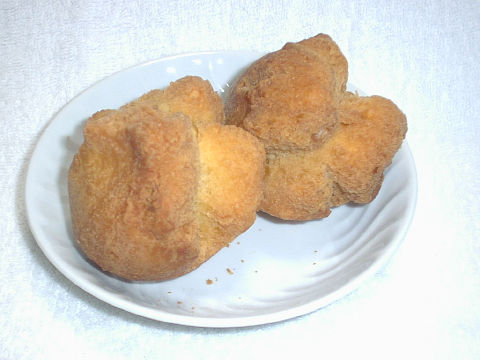
While it is impossible to define every kind of food available in Okinawan cuisines, its intriguing and bold features will make you fall in love with this food-specially when coupled with a glass of awamori or Orion beer, the area’s indigenous liquor.
donut image:http://commons.wikimedia.org/wiki/User:Yatobi
It seems like the Japanese have an inherent ability to make everything they touch amazingly better.
Asian fusion has become increasingly popular in the last ten years, and with that popularity came a surge in the use of Asian condiments: soy sauce, sesame oil, siracha, ginger, hoisin sauce, etc....
One of the more popular condiments is teriyaki sauce. It is sweet, thick and rich and goes well with meat and sea foods. What people don't know is that word Teriyaki describes acooking method, where food is grilled and is glazed with sauce several times. This sauce used in Teriyaki is called "tare," a mixture of honey or sugar,mirin or sake, and soy sauce.
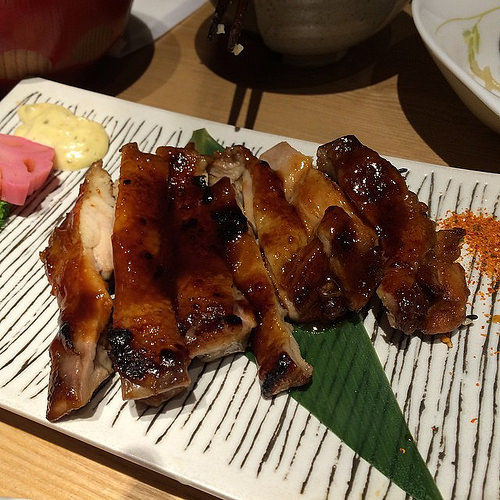
 by coolinsights - Grilled chicken in teriyaki sauce
by coolinsights - Grilled chicken in teriyaki sauce
In North America, Teriyaki sauce is a common condiment, and the ingredients are slightly different from Tare. Store bought Teriyaki sauce is made without sake and have other ingredients such as garlic, brown sugar, fruit juices like orange or pineapple. The focus of this article is on the western-style Teriyaki Sauce. So back to our main question below!
What we are going to ask ourselves today is "Is teriyaki sauce healthy." Sure it tastes really good, but is actually good for you? Let's see!
Teriaki sauce is mainly made of soy sauce with spices, ginger, brown sugar, garlic and pineapple juice added for taste, which makes it a low-calorie sauce, especially when compared to creamier and richer sauces like barbecue sauce, ranch sauce, cheese sauce, etc. One tablespoon of teriyaki sauce has 17 calories, while one tablespoon of ranch sauce has a whopping 73!
However, the brown sugar and pineapple juice make the teriyaki sauce a very sugary condiment and thus high in carbohydrates. 75% of teriyaki sauce's calories come from carbs, which is a lot.
Teriyaki sauce is also very high in sodium, but it is low in saturated fats and cholesterol and a good source of iron (fights fatigue), magnesium (excellent for blood pressure) and phosphorous (good for your kidneys).
Overall, teriyaki sauce is not unhealthy, but it isn't a health food either: it has too much salt, sugar and carbs to be consider truly "healthy." However, when consumed in small amounts, it can easily fit into your daily macros (the macronutrients you have to eat everyday to stay healthy). We do not recommend that you cook with teriyaki sauce everyday, or use it as a dipping sauce often, but using it once or twice week, in small amounts, would not be harmful to your health.
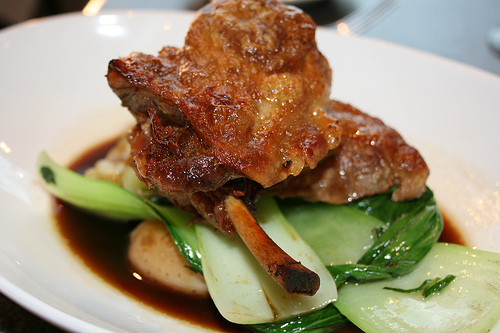
 by Lil' DeeTwice cooked honey & soy farm duck, buerre bosch pears, pink eye potatoes, gingered bok choy & teriyaki sauce
by Lil' DeeTwice cooked honey & soy farm duck, buerre bosch pears, pink eye potatoes, gingered bok choy & teriyaki sauce
Teriyaki sauce is soy sauce's more complex and bolder cousin. As we have seen, teriyaki sauce is mainly made of soy sauce with other ingredients added for taste. There are two kinds of soy sauce: tamari, which is made from soy only and shoyu which is made from both soy and wheat. Both kinds of soy sauce are high in sodium (salt) but contain no sugar or juices and are much lower in carbs than teriyaki sauce.
Soy sauce is healthier than teriyaki sauce: it is simpler and less processed. It also a good source of many minerals such as iron, magnesium and manganese (good for bones and bone structure.) Although it is healthier than teriyaki sauce, soy sauce should be used sparingly because of its high sodium content.
Teriyaki sauce is not unhealthy but should be used in small amounts and not every day. It has numerous health benefits but these benefits hardly offsets the high sodium, sugar and carb contents of the sauce. It should also be said that teriyaki sauce is a much healthier choice than most sauces on the market: if you have to have sauce with your meal, go for teriyaki or soy sauce instead of the creamier sauces like BBQ sauce.